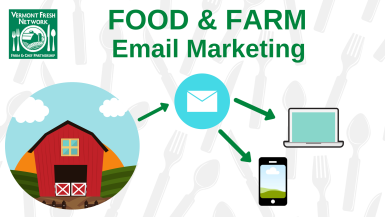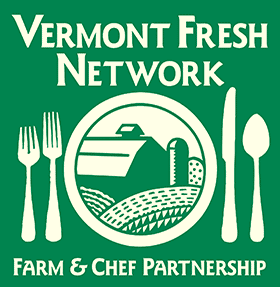Webinar: Email Marketing
 May 7, 2018
May 7, 2018
Email Marketing for Food & Farm Businesses, was recorded on May 2nd, 2018
As a farm or food business, email can be the most effective tool in your digital marketing toolbox. It is a direct link to your customers and your community. And it doesn't have to be "just" marketing - you can provide useful, interesting, and unique information that people want to receive.
In this webinar, we had a conversation on email marketing with two Vermont Fresh Network members: Sarah Webb from Shelburne Farms and Laura Olsen from Green Mountain Girls Farm.
We discussed:
- How to build a balanced content strategy
- The importance of a consistent voice and tone
- List management and segmentation
- How to use email data as a key performance indicator
- Best Practices for email marketing in 2018
You can check out previous webinars in the series in the "Webinar Resources" category of this blog.
Food and Farm Email Marketing Webinar
VFN Webinar: Food and Farm Email marketing
(If you have trouble with the embedded video, the video is also post on Youtube here.)
We were happy to welcome Sarah Web from Shelburne Farms and Laura Olsen from Green Mountain Girls Farm to our webinar on email marketing. They both offered great tips and insight into the process and strategy of email outreach to their communities.
(Tara's secret to email marketing: Email marketing really comes down to two words. Authenticity and sustainability. It's about developing a customer communication practice that is sustainable and true to you. You are the best person to communicate about your farm and/or food business - and whatever approach you choose to your email marketing should be one you feel comfortable with or even (gasp) enjoy. If you prefer photography, share emails that have less writing and more imagery. If you are a stronger writer, focus on that aspect of the newsletter. If you like to draw, draw, if you like to talk, link in audio, if you're an engineer then go ahead and throw in an equation or two (probably not entirely equations, let's not take it too far). There is a reason that you do what you do. All of it comes down to sharing what makes your farm or food business special and being generous with your knowledge.)
Email Marketing Resources
Is email marketing still relevant?
The data shows the answer to this is….Yes! Email is a great way to engage with your customers in real time. And the rise of mobile phone use has had a increased impact on open rates.
Which email service should you use?
It's called "email marketing" but we don't really mean just send an e-mail from your normal account. To send emails regularly to a contact list, organizations and businesses use an email service provider to organize their contacts (including simple subscribe / unsubscribe options), schedule when emails get sent, and measure engagement (how many people open, how many click, etc). Services often have free templates to help make emails attractive, and once you've built a template it's easy to keep your email format consistent without having to think about it each time.
There are many services that you can use to send emails. MailChimp (Free and paid accounts) and Constant Contact (paid accounts) are two of the most popular. If you aren’t sure which is right for you, here is an article discussing various services.
Content
First things first: Your subject line is the readers' first view into what the email is about, and for that reason directly relevant to open rates. This article offers tips and resources on optimizing your email subject line.
Getting past the subject line. . .
It's important to be authentic and offer content that is useful, educational, and relevant to your email community. The Shelburne Farms content strategy that Sarah Webb shared includes breaking up your content into buckets. Shelburne farms break their content into four topics: general brand awareness, informing members and donors about how funds are used in mission related efforts, recruitment for professional development & community, family events, and promotion for the Shelburne Farms online store.
Laura at Green Mountain Girls Farm structures each email into four parts: The intro, a seasonal recipe, what is available at the farm stand, and events for that week at the farm. They use text, lots of photos and sometimes a short video. All of their email content links back to their website.
This strategy can be used for both large and small businesses. It helps you balance and organize your email content. You can set up the content buckets that work best for your farm or food business. (The same strategy can be used to organize your social media too!)
Using strong visuals can increase the emotional connection between the people on your list and your farm / business. Images and video can help readers get a behind-the-scenes look at where their food comes from and connect with your story. (Want more on video? Check out this earlier post)
Email Data and Measuring Performance
Reviewing your data and tracking specific metrics are the most effective ways to gauge email marketing success.
Email churn rates (aka turnover) vary with industry. It's important to remember having a churn rate is completely normal, even a yearly churn rate of 30% is standard. But there are tactics you can use to reduce it.
The click rate is another common statistic - how many people clicked on your e-mail to follow a link. This can be important if you're trying to get folks to do something like go to your website to make an online purchase or if you have long content and readers have to click through to a blog post to see more. Or maybe all you need to tell people is in the e-mail so they won't click through. Or maybe you use this statistic to test what content folks care about the most - will they click to learn more about an event? Or to see the cute baby animal videos? Or get the rest of a recipe?
A third measurement people look at is when their emails are being opened. There's no magic number about how many emails you should send a month or for that matter the perfect time and day to send your newsletter. It all comes down to who you are communicating with. This Constant Contact post lays out the questions you should be asking yourself about your contact list and variables to consider when planning your email schedule.
These measurements are all standing in for a basic question: did people do what you wanted them to do when you sent the e-mail? You can also collect that information on your own - asking people who come to pick up a CSA share if they've tried any of the recipes you sent, adding a question to an event ticket site "how did you hear about this?", including an end of year survey on how people are getting information about your business, etc.
Managing Your Lists
If you currently send emails to your community and are interested in exploring list segmentation (ie. sending something different to different people on the big list), this article has a nice overview of how to think about breaking up groups of contacts into separate lists so that you are including email content that is relevant to all your contacts.
Contact list hygiene is one of the most important elements of contact list management. Which sounds like an unpleasant dental experience. It's more like an unpleasant data entry experience, we're basically talking about making sure the emails you have on the list are the ones you want - in particular that they're still active. You can tell by the bounce rates.
Soft Bounce: When the email address is temporarily unavailable.
Hard Bounce: The email is undeliverable.
You don't want bounces.
Email Marketing Best Practices 2018
-
Use images
-
Be authentic
-
Offer useful and informative content
-
Be mobile responsive (the templates on email services give you this option)
-
Have a clean list
Constant Contact has an extensive resource page for email best practices. MailChimp has this email marketing field guide plus a list of rookie mistakes to avoid.
Shelburne Farms is a nonprofit organization, a 1400 acre working farm and a National Historic Landmark. For over 40 years, it has offered educational opportunities for children of all ages to learn about sustainability and their connections to the natural and agricultural world. Shelburne Farms produces many products on their working farm including cheddar cheese, fruits and vegetables, meat and maple syrup. Their products are sold at farmer’s markets, at their welcome center, through an online store, and at the Inn at Shelburne Farms.
Green Mountain Girls Farm is a small diversified farm located in central Vermont. Rutland native Mari Omland and UVM graduate Laura Olsen returned to Vermont in 2007 after enjoying careers in conservation and smart-growth non-profits. This mid-career shift into agriculture merged their former worlds of eco-tourism, organizational management, environmental and land use advocacy, and gardening with a passion for quality food. They sell their products at the farm, and local farmers markets, in addition to having a CSA. Visitors can also experience Green Mountain Girls farm life by staying at the Barn guest house or by having a paid farm experience such as learning to milk, collecting eggs or being farmer-in-training.

